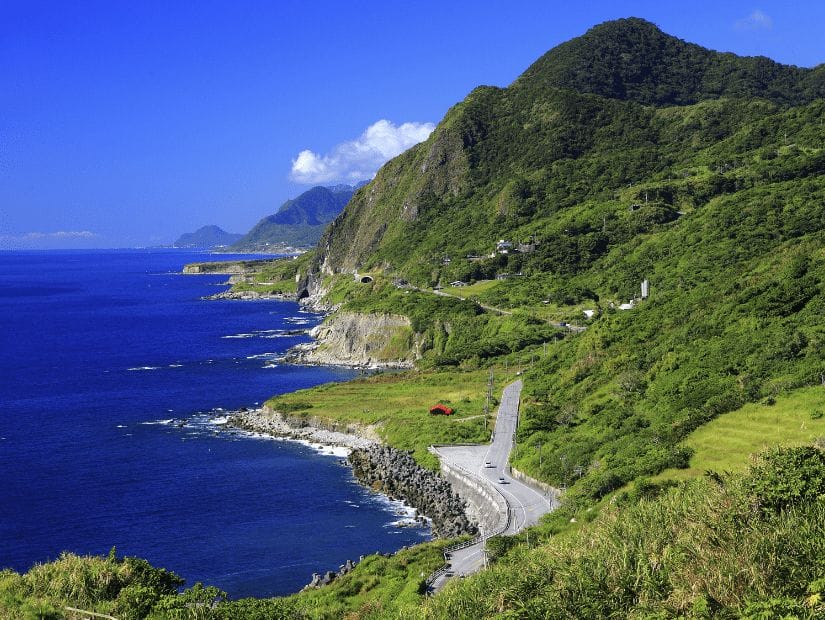East Taiwan

Often called Taiwan’s Hawaii, Taiwan’s east is every bit as welcoming and lushly tropical as the comparison implies. Just like the US island chain, the counties of Hualien and Taitung are home to a multi-ethnic population. Living among them are artists, dreamers, retirees and entrepreneurs who’ve exiled themselves from the big cities which characterise the western half of Taiwan. Many Taiwanese, as well as outsiders lucky enough to enjoy a comprehensive Taiwan tour, says it’s their favourite part of the country.
Hualien and Taitung have one fifth of Taiwan’s total land area, but a mere 555,000 people, less than 3% of the country’s population. Agricultural and forestry dominate the landscape. Hualien City, the most important settlement, has an endearing ‘not so small you can’t get what you need, not so big there are traffic jams’ vibe, not to mention a good range of hotels and restaurants. It’s no wonder many tourists choose to base themselves here, and make day-long excursions to Taroko Gorge or points south.
Those flying into the city may well notice its most impressive landmark Before they land. The Hall of Still Thoughts is a dignified grey edifice quite unlike most Taiwanese temples. It’s the spiritual center of Tzu Chi, a Buddhist charity said to be largest non-governmental organisation in the Chinese-speaking world. Tzu Chi’s four million members are active in medical work, education and disaster relief in Taiwan and overseas. The hall is open to the public and has multilingual displays about the group’s goals and achievements. Visitors can wind down inside the vast and utterly tranquil chapel.
Taroko Gorge is a true must-see, but certainly not the only major attractions in the Hualien-Taitung region. The East Rift Valley and the Pacific coastline deserve two full days each.
The valley is a 152-km-long expanse of prime farmland between the Central Mountain Range (more than 100 peaks taller than 3,000 m / 9,843 ft) to the west and the Coastal Mountain Range (highest point 1,682 m / 5,518 ft) to the east. Taiwan’s best rice is grown here, and organic farmers make the most of the pristine environment. The inland side of the valley is dotted with hot springs.

Some of these natural spas have been popular since the Japanese colonial era and still show considerable Japanese influence. One is Ruisui, where the yellowish spring water averages 48 degrees Celsius (118 degrees Fahrenheit) and is rich in iron. Another is Antong, where the water is even hotter.
Serious hot-springs fans may want to add Zhiben, which is outside the East Rift Valley and just south of Taitung City, to their itinerary. The soothing waters here have been drawing tourists since the 1920s. An excellent way of working up a sweat before getting in the tub (there are both public pools where swimsuits are required, and private rooms) is to explore Zhiben National Forest Recreation Area. This 111-hectare nature reserve has both semi-rainforest and mixed forest, plus a macaque population that’s neither timid nor troublesome.
Other highlights along the inland route from Hualien to Taitung include the Amis aboriginal village of Dabalong. This is one of several places where the tribe’s summertime Harvest Festival is celebrated with gusto, and it’s home to a number of renowned woodcarvers.
Nearby Fuyuan National Forest Recreation Area is excellent for birding (throughout the year), butterflies (March until August) and fireflies (March-May and again October-November).
Taiwan’s most popular whitewater-rafting course, Hualien County’s Xiuguluan River, links the East Rift Valley with the Pacific. Each float lasts three to four hours, during which a professional guide helps each 10-person inflatable negotiate 24 thrilling kilometres of rapids, drops and eddies. Helmets and lifejackets are provided.
Highway 11 stays within sight of the Pacific all the way from Hualien to Taitung, more than 180 km to the south. The road is much loved by Taiwan’s cycling fraternity, but richly rewards all who travel it, be they on four wheels or two.
Some of the settlements along the way are dominated by Amis clans. Others, such as Chenggong, are part-Han Chinese, part-indigenous. Chenggong is one of Taiwan’s most important fisheries centres.
There are beaches and coves where surfing and snorkelling are popular pastimes, but for many the coast’s geological curiosities leave a deeper impression. One of these, Sanxiantai (Terraces of the Three Immortals), is a monument to the power of nature. Wind and wave erosion turned what was originally a little peninsula into an island now linked to Taiwan’s mainland by a photogenic if impractical eight-arch pedestrian bridge.
Not all coast-travellers go as far south as Taitung City. A good number stop at the modest fishing harbour further called Fugang, because it’s the jumping-off point for excursions to the scuba paradise of Green Island and the remote, aboriginal-populated outpost of Orchid Island.



